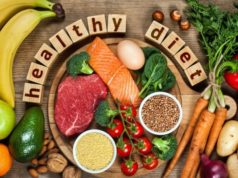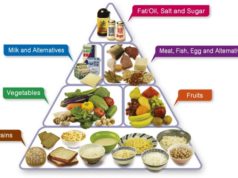Popular diets, they’re everywhere you look! From the latest celebrity-endorsed cleanse to the ancient wisdom of the caveman, the quest for the perfect eating plan has captivated humanity for ages. But what’s behind the allure of these trendy diets? Are they truly the path to health and happiness, or just fleeting fads that leave us feeling more confused than ever?
This exploration delves into the fascinating world of popular diets, examining their history, their core principles, and the science behind their effectiveness. We’ll uncover the reasons behind their popularity, explore the ethical considerations surrounding their promotion, and ultimately, offer a roadmap for creating a balanced and sustainable approach to healthy eating.
Definition and History of Popular Diets
Diets have become a significant part of our lives, often shaping our eating habits and influencing our perceptions of health and well-being. “Popular diets” refer to specific dietary plans that gain widespread attention and appeal to a large segment of the population.
These diets often emerge as a response to prevailing societal trends, cultural beliefs, and scientific advancements, with their popularity fluctuating over time.
Evolution of Popular Diets
Popular diets have evolved throughout history, reflecting changing societal values and scientific understanding. From ancient times to the modern era, these dietary trends have been influenced by factors such as religious beliefs, cultural norms, economic conditions, and scientific discoveries.
Ancient Diets
Ancient civilizations often developed dietary practices based on their cultural beliefs and the availability of food resources. For example, the ancient Greeks emphasized a balanced diet of fruits, vegetables, grains, and legumes, while the ancient Romans favored a diet rich in meat, bread, and wine.
Medieval Diets
During the Middle Ages, religious beliefs heavily influenced dietary practices. The Catholic Church’s rules on fasting and abstinence shaped eating habits, leading to periods of strict food restrictions.
Renaissance and Enlightenment Diets
The Renaissance and Enlightenment periods witnessed a shift towards a more scientific approach to diet. The development of new food preservation techniques and increased trade led to a wider variety of foods available.
19th and 20th Centuries
The 19th and 20th centuries saw the rise of modern diets, influenced by the emergence of scientific disciplines such as nutrition and dietetics. Diets focused on specific nutrients, such as carbohydrates, fats, and proteins, gained popularity, with the introduction of calorie counting and other dietary guidelines.
Modern Diets
In the 21st century, popular diets continue to evolve, driven by a growing awareness of health and wellness, as well as the increasing availability of information and technology. Diets emphasizing specific food groups, such as the Mediterranean diet or the ketogenic diet, have gained widespread popularity.
Key Trends in Popular Diets
Throughout history, certain trends have repeatedly emerged in popular diets:
- Focus on Specific Food Groups:Diets often emphasize the consumption of certain food groups, such as fruits, vegetables, or lean protein, while limiting others, such as processed foods or sugary drinks.
- Weight Loss Emphasis:Many popular diets are primarily aimed at weight loss, often promoting calorie restriction, fat reduction, or carbohydrate restriction.
- Health Benefits:Diets often claim to provide health benefits beyond weight loss, such as improved heart health, reduced risk of chronic diseases, or enhanced cognitive function.
- Simplicity and Convenience:Diets that are easy to follow and fit into busy lifestyles often gain popularity.
- Celebrity Endorsements:Celebrities and public figures often promote specific diets, influencing their popularity.
Influential Figures
Throughout history, various individuals have played a significant role in shaping the landscape of popular diets:
- Hippocrates (c. 460-370 BCE):Considered the “Father of Medicine,” Hippocrates emphasized the importance of a balanced diet for health and well-being. He believed in the concept of “moderation” and the need for a diverse range of foods.
- William Banting (1826-1878):A British undertaker, Banting published a book titled “Letter on Corpulence” in 1863, outlining a low-carbohydrate diet that became popular for weight loss.
- John Harvey Kellogg (1852-1943):A physician and health reformer, Kellogg advocated for a vegetarian diet and promoted the use of whole grains and other healthy foods.
- Horace Fletcher (1849-1919):Known as the “Great Masticator,” Fletcher emphasized the importance of thorough chewing and advocated for a diet based on fresh fruits and vegetables.
- Ancel Keys (1904-2004):A physiologist and epidemiologist, Keys conducted the groundbreaking Seven Countries Study, which linked dietary fat intake to heart disease. His findings influenced the development of dietary guidelines for reducing heart disease risk.
Examples of Popular Diets Throughout History
- The Mediterranean Diet:This diet, characterized by its emphasis on fruits, vegetables, whole grains, legumes, olive oil, and fish, has gained popularity for its potential health benefits, including reduced risk of heart disease and stroke.
- The Atkins Diet:Introduced in the 1970s, this diet emphasizes a very low intake of carbohydrates and a high intake of protein and fat. It became popular for its rapid weight loss results, but its long-term effectiveness and safety have been debated.
- The South Beach Diet:Similar to the Atkins diet, this diet focuses on limiting carbohydrates but allows for a wider range of healthy foods, such as fruits and vegetables. It emphasizes the importance of managing blood sugar levels.
- The Paleo Diet:This diet mimics the eating habits of our prehistoric ancestors, emphasizing whole, unprocessed foods like meat, fish, fruits, vegetables, and nuts. It eliminates grains, dairy, and processed foods.
- The Ketogenic Diet:This diet involves consuming a very high amount of fat, a moderate amount of protein, and a very low amount of carbohydrates. It forces the body to enter a state of ketosis, where it burns fat for energy.
Types of Popular Diets
The world of dieting is a vast and often confusing landscape, with countless approaches promising rapid weight loss and a healthier lifestyle. However, beneath the marketing hype, most popular diets can be categorized into a few core principles. Understanding these principles can help you navigate the diet world with more clarity and make informed decisions about your own health and well-being.
From the keto craze to the latest juice cleanse, popular diets are always popping up, promising quick weight loss and a healthier you. But hold your horses, dieters! Before you ditch the carbs or go all-in on green smoothies, let’s talk about those sneaky diet sodas.
You might think they’re a guilt-free way to quench your thirst, but why are diet sodas bad for you ? Turns out, those artificial sweeteners can mess with your gut bacteria and might even lead to weight gain in the long run.
So, maybe ditch the diet soda and focus on real food – your body (and your taste buds) will thank you for it!
Calorie Restriction Diets
Calorie restriction diets are based on the simple principle of consuming fewer calories than your body burns, creating a calorie deficit that forces your body to tap into stored energy reserves (fat) for fuel. This approach is the foundation of many popular weight-loss programs, and it’s backed by solid scientific evidence.
Here are some examples of calorie restriction diets:
- Weight Watchers:This program assigns points to foods based on their calorie and fat content, encouraging users to make healthy choices within a calorie budget.
- The Mediterranean Diet:While not strictly a calorie restriction diet, the Mediterranean diet emphasizes whole, unprocessed foods, which are generally lower in calories than highly processed foods, contributing to a natural calorie reduction.
- Intermittent Fasting:This approach involves alternating periods of eating and fasting, typically by limiting calorie intake to specific windows of time each day or week. It can lead to a calorie deficit without drastically changing your overall dietary intake.
Macronutrient Manipulation Diets
These diets focus on adjusting the proportions of macronutrients (carbohydrates, protein, and fat) in your diet, rather than solely on calorie restriction.
- Ketogenic Diet:The ketogenic diet, or “keto” for short, drastically reduces carbohydrate intake and replaces it with fat. This forces your body to enter a state of ketosis, where it begins to burn fat for energy instead of carbohydrates.
- Paleo Diet:This diet encourages eating foods that our ancestors ate in the Paleolithic era, emphasizing whole, unprocessed foods like lean meats, fruits, vegetables, and nuts. It typically limits grains, dairy, legumes, and processed foods, often resulting in a lower carbohydrate intake.
- High-Protein Diets:These diets prioritize protein intake, aiming to increase satiety, preserve muscle mass during weight loss, and boost metabolism. They often involve reducing carbohydrate intake to some degree.
Specific Food Elimination Diets
These diets eliminate certain food groups or individual foods believed to cause health problems or trigger allergies.
- Gluten-Free Diet:This diet eliminates gluten, a protein found in wheat, barley, and rye, which can trigger autoimmune reactions in individuals with celiac disease. It is also often followed by people with gluten sensitivity or who believe it contributes to digestive issues or other health problems.
From the keto craze to the latest juice cleanse, popular diets come and go faster than you can say “kale smoothie.” But sometimes, what you really need is a diet that’s good for your health, like how to low cholesterol diet.
It’s all about keeping those numbers in check and feeling your best, even if it doesn’t involve trendy superfoods or crazy restrictions. So, ditch the fad diets and focus on what truly matters: healthy eating for a healthy life.
- Dairy-Free Diet:This diet eliminates dairy products, which contain lactose, a sugar that some people cannot digest properly. This can be beneficial for individuals with lactose intolerance or who have dairy allergies.
- Vegan Diet:This diet excludes all animal products, including meat, poultry, fish, eggs, and dairy. It is often followed for ethical, environmental, or health reasons.
Table of Popular Diets
| Diet Name | Core Principles | Typical Food Plan | Potential Benefits | Potential Risks |
|---|---|---|---|---|
| Weight Watchers | Calorie restriction | Points-based system for food choices, emphasizing healthy options | Weight loss, improved diet quality | Can be restrictive, may require significant lifestyle changes |
| Mediterranean Diet | Calorie restriction, emphasis on whole, unprocessed foods | Fruits, vegetables, whole grains, olive oil, fish, legumes, nuts | Weight loss, reduced risk of heart disease, improved cognitive function | May be challenging to maintain long-term, can be expensive |
| Intermittent Fasting | Calorie restriction through time-restricted eating | Alternating periods of eating and fasting | Weight loss, improved insulin sensitivity, reduced inflammation | May cause hunger and fatigue, can be difficult to sustain |
| Ketogenic Diet | Macronutrient manipulation, high fat, low carbohydrate | High-fat foods like meat, fish, eggs, cheese, avocados, nuts, and seeds | Weight loss, improved blood sugar control, reduced seizures in some individuals | Potential for nutrient deficiencies, digestive issues, kidney stones |
| Paleo Diet | Macronutrient manipulation, emphasis on whole, unprocessed foods | Lean meats, fish, fruits, vegetables, nuts, and seeds | Weight loss, improved blood sugar control, reduced inflammation | May be restrictive, can be expensive, potential for nutrient deficiencies |
| High-Protein Diets | Macronutrient manipulation, high protein intake | High-protein foods like meat, fish, poultry, eggs, beans, and lentils | Increased satiety, muscle preservation during weight loss, boosted metabolism | Potential for kidney problems, dehydration, constipation |
| Gluten-Free Diet | Specific food elimination | Elimination of wheat, barley, and rye | Improved digestive health for individuals with celiac disease or gluten sensitivity | Potential for nutrient deficiencies, limited food choices, can be expensive |
| Dairy-Free Diet | Specific food elimination | Elimination of dairy products | Improved digestive health for individuals with lactose intolerance or dairy allergies | Potential for nutrient deficiencies, limited food choices |
| Vegan Diet | Specific food elimination | Elimination of all animal products | Weight loss, reduced risk of heart disease, improved blood sugar control | Potential for nutrient deficiencies, limited food choices, can be challenging to maintain |
Popularity Factors
Diets, like fashion trends, ebb and flow in popularity. What makes one diet skyrocket to the top of the “most popular” list while another fades into obscurity? The answer lies in a complex interplay of factors, from the allure of quick fixes to the influence of social media and celebrity endorsements.
The Media’s Role in Diet Popularity
The media plays a significant role in shaping our perceptions of diets. Magazines, newspapers, television shows, and social media platforms are constantly bombarded with diet-related content. This constant exposure can create a sense of urgency and make us feel like we need to be on a diet to achieve a “perfect” body.
- Sensationalized Headlines:Headlines like “Lose 10 Pounds in 10 Days!” or “The Miracle Diet That Melts Away Fat” often attract attention but can be misleading and unrealistic.
- “Before and After” Photos:Dramatic “before and after” photos can be powerful visual tools, but they can also be misleading. These photos often represent extreme cases and may not reflect the average person’s experience.
- Celebrity Endorsements:Celebrity endorsements can significantly boost a diet’s popularity. When a well-known figure promotes a diet, it can create a sense of legitimacy and make it seem more appealing.
Social Trends and the Desire for Belonging
Diets can become social trends, spreading like wildfire through social media and word-of-mouth. This can be attributed to the desire for belonging and validation.
From the keto craze to the intermittent fasting frenzy, popular diets come and go like the seasons. But before you jump on the latest bandwagon, remember to do your research! Understanding the Keywords associated with each diet can help you make informed choices and avoid falling prey to fad trends.
After all, a healthy diet should be sustainable, not just a temporary fix for your waistline.
- Social Media Influencers:Social media influencers, with their large followings, can create a buzz around certain diets. Their posts, stories, and videos can inspire people to try new diets, especially if they see their friends and peers doing so.
- Group Dynamics:Joining a diet group or community can provide a sense of support and accountability. This shared experience can make it easier to stick to the diet and feel like you’re part of something bigger.
Psychological Motivations
The desire to lose weight and improve our appearance is a powerful motivator, but it’s not the only reason people adopt diets.
- Self-Esteem and Body Image:Many people struggle with self-esteem and body image issues. Dieting can be a way to try to control these feelings and achieve a more desirable physique.
- Control and Empowerment:Dieting can provide a sense of control and empowerment, especially in times of stress or uncertainty. The ability to make choices about what we eat can be comforting and reassuring.
- Health and Wellness:Some people adopt diets for health reasons, such as managing chronic diseases or improving their overall well-being.
Scientific Evidence and Effectiveness

The popularity of diets often precedes scientific evidence, leading to a mixed bag of results. While some diets might offer short-term weight loss, their long-term efficacy and impact on overall health remain under scrutiny.
Scientific Evidence for Popular Diets
The scientific evidence supporting the effectiveness of popular diets is often limited and contradictory. While some diets may show promising results in short-term studies, their long-term effects and impact on overall health are less clear. Many studies are limited by factors such as small sample sizes, short durations, and lack of long-term follow-up.
It’s crucial to approach claims of diet effectiveness with a critical eye and consider the limitations of the research.
Long-Term Health Outcomes
Long-term health outcomes associated with different diets can vary significantly. Some diets may lead to initial weight loss but can have negative consequences for overall health in the long run. For example, diets that are overly restrictive or eliminate entire food groups can lead to nutrient deficiencies, metabolic imbalances, and an increased risk of chronic diseases.
Potential Risks and Side Effects
Following popular diets can pose potential risks and side effects. Some diets may lead to:
- Nutrient deficiencies: Restrictive diets may limit the intake of essential vitamins and minerals, leading to deficiencies.
- Metabolic imbalances: Diets that drastically alter calorie intake or macronutrient ratios can disrupt metabolic processes.
- Digestive issues: Some diets, particularly those high in fiber or low in carbohydrates, can cause digestive problems such as bloating, gas, and constipation.
- Food cravings: Diets that restrict certain foods can lead to intense cravings and make it difficult to maintain long-term adherence.
- Psychological distress: The constant focus on food and weight can lead to anxiety, depression, and disordered eating patterns.
It’s important to note that these risks and side effects can vary depending on the specific diet, individual health status, and adherence to the diet.
Ethical Considerations
The allure of quick fixes and the pursuit of the “perfect” body often overshadow the ethical implications of promoting certain diets. While some diets may offer short-term weight loss, their long-term effects, particularly on mental and physical health, raise serious ethical concerns.
Diet Culture and Body Image
Diet culture, a pervasive set of beliefs that equates thinness with health, beauty, and success, contributes significantly to body image issues and eating disorders. The relentless pressure to conform to unrealistic beauty standards can lead to disordered eating patterns, low self-esteem, and a distorted perception of one’s body.
“Diet culture is a system of beliefs that equates thinness with health, beauty, and success. It is a system that promotes weight loss as the ultimate goal, often at the expense of health and well-being.” Dr. Alexis Conason, psychiatrist and author
The promotion of restrictive diets, often accompanied by unrealistic claims of rapid weight loss, can exacerbate these issues. The constant focus on weight and body size can lead to a cycle of dieting, restriction, and guilt, ultimately harming individuals’ mental and physical health.
Sustainable Diet Choices: Popular Diets
Dieting can be a rollercoaster ride of restrictions and cravings, but the real goal is to find a way of eating that feels good, fuels your body, and fits seamlessly into your life. This is where sustainable diet choices come in – they’re about creating a long-term, healthy relationship with food that nourishes you from the inside out.
Creating a Balanced and Sustainable Diet
The key to creating a sustainable diet is finding a balance that works for you. It’s about finding a way of eating that you enjoy and can stick to over the long term. This means incorporating foods you love, but also ensuring you’re getting the nutrients your body needs.
Here are some tips for creating a balanced and sustainable diet:
- Listen to your body:Pay attention to your hunger and fullness cues. Eat when you’re hungry and stop when you’re satisfied.
- Make gradual changes:Don’t try to overhaul your diet overnight. Start by making small, sustainable changes that you can maintain over time. For example, try adding one new fruit or vegetable to your daily diet or swapping out sugary drinks for water.
- Incorporate a variety of foods:Aim to eat a rainbow of fruits, vegetables, whole grains, lean proteins, and healthy fats. This ensures you’re getting a wide range of nutrients.
- Plan ahead:Take some time each week to plan your meals and snacks. This can help you make healthier choices and avoid impulse purchases.
- Be mindful of portion sizes:It’s easy to overeat, especially when eating out. Be mindful of portion sizes and don’t be afraid to ask for a to-go box.
- Cook more meals at home:Cooking at home gives you more control over the ingredients and portion sizes. It also allows you to experiment with new recipes and flavors.
- Don’t be afraid to indulge occasionally:Allow yourself to enjoy your favorite foods in moderation. Depriving yourself can lead to cravings and binge eating.
Incorporating Nutrient-Rich Foods
Eating a variety of nutrient-rich foods is crucial for optimal health and well-being. It’s not just about calories; it’s about providing your body with the essential vitamins, minerals, and antioxidants it needs to function properly.Here are some examples of nutrient-rich foods to incorporate into your diet:
- Fruits and Vegetables:These are packed with vitamins, minerals, fiber, and antioxidants. Aim for at least five servings a day.
- Whole Grains:Choose whole grains over refined grains whenever possible. Whole grains are a good source of fiber, which helps regulate digestion and can help you feel fuller for longer.
- Lean Protein:Protein is essential for building and repairing tissues. Good sources of lean protein include fish, poultry, beans, lentils, tofu, and eggs.
- Healthy Fats:Healthy fats are important for heart health and brain function. Good sources of healthy fats include olive oil, avocados, nuts, and seeds.
Mindful Eating Practices
Mindful eating is about being present and aware of your food choices. It’s about slowing down, savoring your food, and paying attention to your body’s signals. Here are some tips for practicing mindful eating:
- Eat without distractions:Turn off the TV, put away your phone, and focus on your food.
- Chew your food thoroughly:This helps your body digest food properly and can help you feel fuller faster.
- Pay attention to your hunger and fullness cues:Eat when you’re hungry and stop when you’re satisfied.
- Appreciate the taste and texture of your food:Take time to savor each bite.
- Be patient:It takes time to develop mindful eating habits. Be patient with yourself and don’t get discouraged if you slip up occasionally.
Final Thoughts
So, as you navigate the ever-changing landscape of popular diets, remember that the key to lasting health and well-being lies not in chasing the latest fad, but in understanding your individual needs and making choices that support your long-term goals.
After all, the best diet is one that you can actually stick to, and that brings you joy!
Questions Often Asked
What’s the difference between a fad diet and a sustainable diet?
A fad diet is typically short-term, restrictive, and often based on questionable science. Sustainable diets, on the other hand, emphasize balanced eating, long-term health, and individual needs.
Are all popular diets unhealthy?
Not necessarily. Some popular diets, like the Mediterranean diet, are known for their health benefits and have a strong foundation in scientific research. However, it’s crucial to consult with a healthcare professional before embarking on any new diet.
Is it okay to try a popular diet for a short period?
While it’s generally not recommended to rely on fad diets for long-term weight management, trying a popular diet for a short period might be fine if you’re motivated and have the support of a healthcare professional. However, remember that sustainable changes are more likely to lead to lasting results.
























